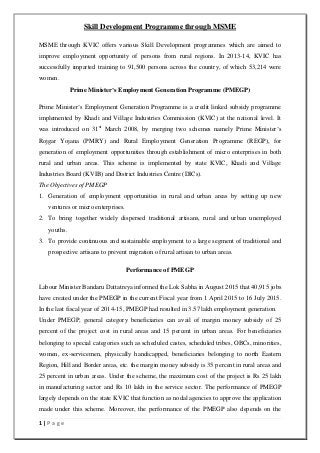Report
Share
Download to read offline

Recommended
More Related Content
Featured
Featured (20)
Product Design Trends in 2024 | Teenage Engineerings

Product Design Trends in 2024 | Teenage Engineerings
How Race, Age and Gender Shape Attitudes Towards Mental Health

How Race, Age and Gender Shape Attitudes Towards Mental Health
AI Trends in Creative Operations 2024 by Artwork Flow.pdf

AI Trends in Creative Operations 2024 by Artwork Flow.pdf
Content Methodology: A Best Practices Report (Webinar)

Content Methodology: A Best Practices Report (Webinar)
How to Prepare For a Successful Job Search for 2024

How to Prepare For a Successful Job Search for 2024
Social Media Marketing Trends 2024 // The Global Indie Insights

Social Media Marketing Trends 2024 // The Global Indie Insights
Trends In Paid Search: Navigating The Digital Landscape In 2024

Trends In Paid Search: Navigating The Digital Landscape In 2024
5 Public speaking tips from TED - Visualized summary

5 Public speaking tips from TED - Visualized summary
Google's Just Not That Into You: Understanding Core Updates & Search Intent

Google's Just Not That Into You: Understanding Core Updates & Search Intent
The six step guide to practical project management

The six step guide to practical project management
Beginners Guide to TikTok for Search - Rachel Pearson - We are Tilt __ Bright...

Beginners Guide to TikTok for Search - Rachel Pearson - We are Tilt __ Bright...
Skill Development Programme through MSME
- 1. 1 | P a g e Skill Development Programme through MSME MSME through KVIC offers various Skill Development programmes which are aimed to improve employment opportunity of persons from rural regions. In 2013-14, KVIC has successfully imparted training to 91,500 persons across the country, of which 53,214 were women. Prime Minister’s Employment Generation Programme (PMEGP) Prime Minister’s Employment Generation Programme is a credit linked subsidy programme implemented by Khadi and Village Industries Commission (KVIC) at the national level. It was introduced on 31st March 2008, by merging two schemes namely Prime Minister’s Rojgar Yojana (PMRY) and Rural Employment Generation Programme (REGP), for generation of employment opportunities through establishment of micro enterprises in both rural and urban areas. This scheme is implemented by state KVIC, Khadi and Village Industries Board (KVIB) and District Industries Centre (DICs). The Objectives of PMEGP 1. Generation of employment opportunities in rural and urban areas by setting up new ventures or micro enterprises. 2. To bring together widely dispersed traditional artisans, rural and urban unemployed youths. 3. To provide continuous and sustainable employment to a large segment of traditional and prospective artisans to prevent migration of rural artisan to urban areas. Performance of PMEGP Labour Minister Bandaru Dattatreya informed the Lok Sabha in August 2015 that 40,915 jobs have created under the PMEGP in the current Fiscal year from 1 April 2015 to 16 July 2015. In the last fiscal year of 2014-15, PMEGP had resulted in 3.57 lakh employment generation. Under PMEGP, general category beneficiaries can avail of margin money subsidy of 25 percent of the project cost in rural areas and 15 percent in urban areas. For beneficiaries belonging to special categories such as scheduled castes, scheduled tribes, OBCs, minorities, women, ex-servicemen, physically handicapped, beneficiaries belonging to north Eastern Region, Hill and Border areas, etc. the margin money subsidy is 35 percent in rural areas and 25 percent in urban areas. Under the scheme, the maximum cost of the project is Rs 25 lakh in manufacturing sector and Rs 10 lakh in the service sector. The performance of PMEGP largely depends on the state KVIC that function as nodal agencies to approve the application made under this scheme. Moreover, the performance of the PMEGP also depends on the
- 2. 2 | P a g e Public Sector Banks that has to extend the credit. During 2014-15 (till December 2014) 3, 37,070 applications have been received under the scheme of which 1,39,410 projects were recommended to banks. Banks have however sanctioned 32,924 cases and made disbursement only in 18,141 cases the year. Thus it is evident that there is large gap in the applications made and those sanctioned under PMEGP. As per the name – Prime Minister’s Employment Generation Programme suggests, it is intended to provide employment. However fewer applications being approved and disbursements made in far less instances will have a direct impact on the employment. There is an urgent need to study the reasons for large scale rejections, which happens to be 41.35 percent of the applications received and tardy disbursement of funds by the banks under the scheme which happens to be 55 percent of the sanctioned applications for the corresponding periods. If it is lack of funds that has been dictating the fate of the applications then appropriate provisions need to be made for allocating more funds. On the other hand, if applications are being rejected for other reasons, then the same need to be studied and addressed so that there are more beneficiaries of this flagship scheme. Road Ahead Though no break-up of urban and rural areas under this scheme is available for this fiscal, the overall release of funds indicates a marked departure from the past. This fiscal till July 16, the government has released Rs 1019 crore as margin money subsidy, whereas in the entire previous fiscal year the margin money subsidy amounted to Rs 1093.06 crore.
